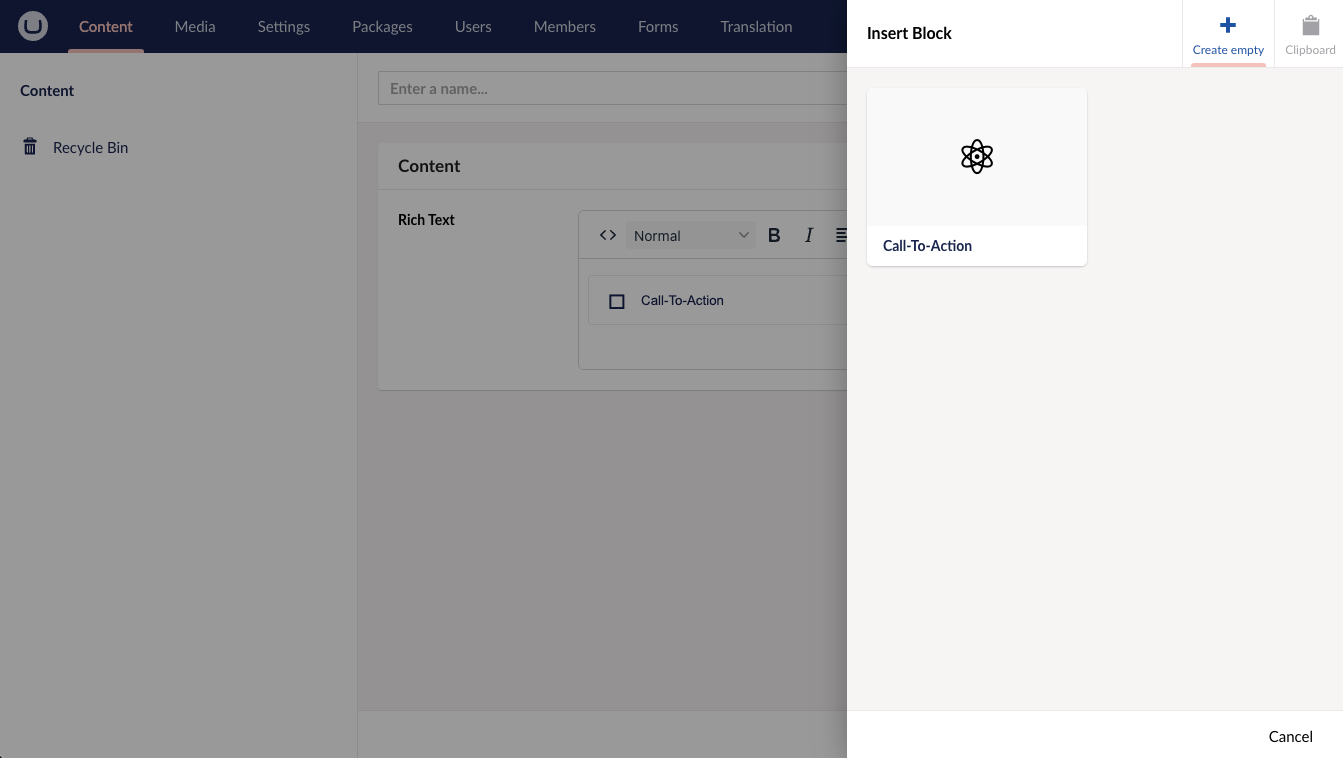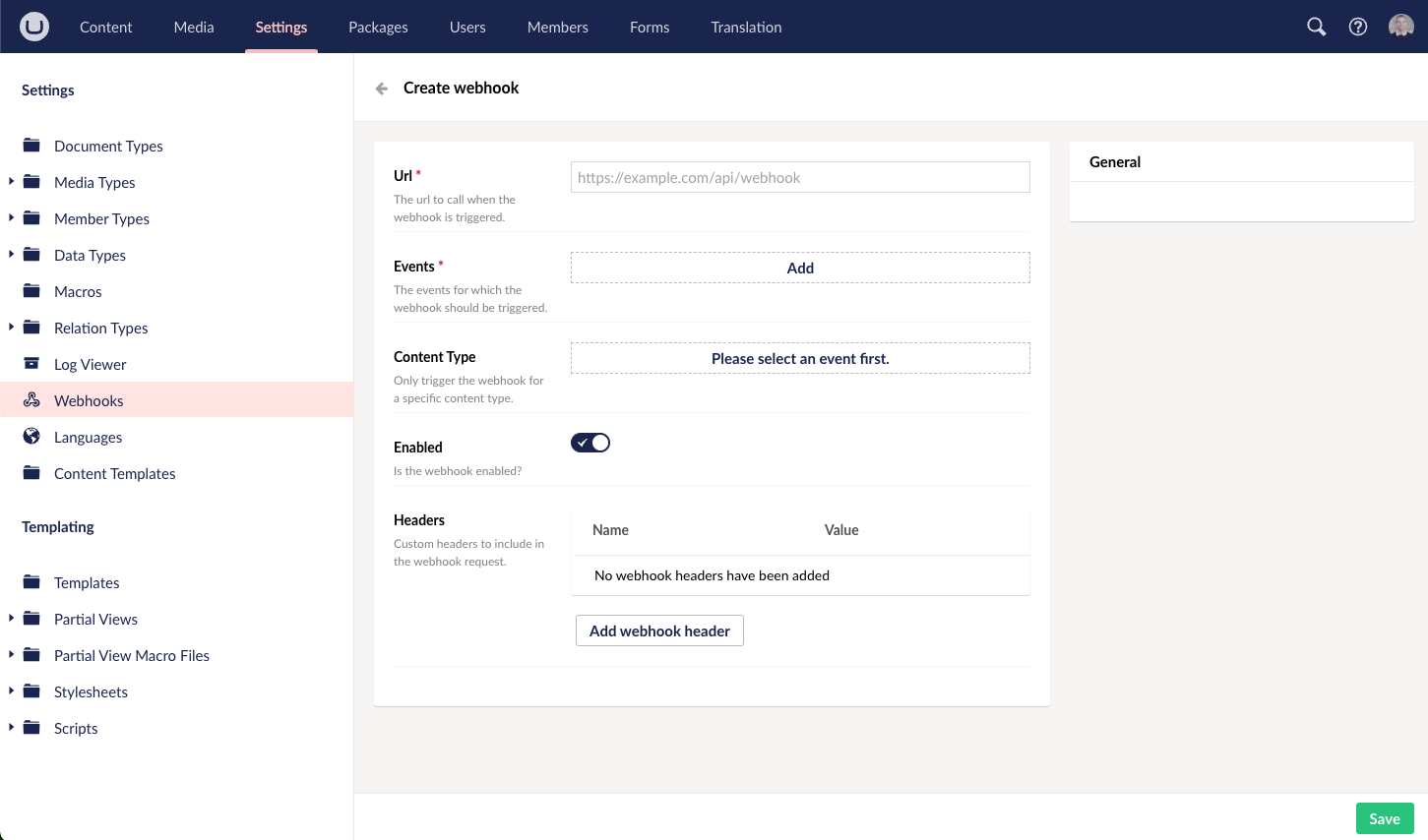Are you ready to take your website or application to the next level?
Look no further than Umbraco CMS, the ultimate solution for creating dynamic and tailored digital experiences. With its advanced features and robust capabilities, Umbraco CMS empowers you to efficiently manage your content, collaborate with team members, and deliver personalised experiences to your website visitors.
Umbraco CMS is a powerful content management system that provides flexibility and scalability for building websites and applications. In this comprehensive guide, we will explore everything you need to know about Umbraco CMS and how to leverage its features to create exceptional digital experiences.
By the end of this ultimate guide, you will have a solid understanding of Umbraco CMS and be equipped with the knowledge to make an informed decision about choosing Umbraco for your business.
So, let's dive in and unlock the full potential of Umbraco CMS!

We've built over 150 serious websites for our clients
Table of Contents
- Introduction to Umbraco CMS
- Getting Started with Umbraco CMS
- Installation and Setup
- Understanding the Umbraco Interface
- Creating and Managing Content
- Customising Umbraco CMS
- Extending Functionality with Packages
- Templating and Theming
- Working with Document Types and Templates
- Advanced Features of Umbraco CMS
- Data Manipulation and Querying
- Workflow and Publishing
- Multilingual and Localisation Support
- Optimising Performance and Security
- Caching and Performance Optimisation
- User Permissions and Access Control
- Security Best Practices
- Integrating Umbraco CMS with External Systems
- API Integration
- Third-Party Services and Platforms
- E-commerce Integration
- Troubleshooting and Maintenance
- Common Issues and Solutions
- Upgrading Umbraco CMS
- Backups and Disaster Recovery
- Resources and Community Support
- Official Documentation and Guides
- Umbraco Community and Forums
- Training and Certification Programs
1. Introduction to Umbraco CMS
Umbraco CMS is a robust and versatile content management system that empowers developers and content creators to build and manage websites and applications with ease. It is an open-source platform that combines flexibility, scalability, and user-friendliness, making it a popular choice among businesses and developers worldwide.
With Umbraco CMS, you have full control over your digital content. Whether you're creating a simple blog or a complex enterprise website, Umbraco provides a comprehensive set of tools and features to streamline your content creation, management, and delivery processes.
One of the key strengths of Umbraco CMS is its extensibility. It offers a wide range of packages, plugins, and integrations that allow you to tailor the platform to meet your specific needs. Whether you need e-commerce functionality, multilingual support, or advanced SEO capabilities, Umbraco has got you covered.
Umbraco CMS combines flexibility, scalability, and a user-friendly interface, empowering both technical and non-technical users to collaborate seamlessly and create exceptional digital experiences.
In addition to its flexibility, Umbraco CMS boasts a user-friendly interface that enables both technical and non-technical users to collaborate seamlessly. Content creators can easily manage and update content without any coding knowledge, while developers can leverage the platform's powerful APIs and customisation options to create unique and engaging digital experiences.

In this ultimate guide, we will take you on a journey through the various aspects of Umbraco CMS. From the basics of installation and content management to advanced features like data manipulation and integration with external systems, you will gain a comprehensive understanding of how to harness the full potential of Umbraco CMS.
So, whether you're a developer looking to build websites for clients or a content creator aiming to deliver exceptional digital experiences, this guide will equip you with the knowledge and tools to succeed with Umbraco CMS. Let's get started!
2. Getting Started with Umbraco CMS
Installation and Setup
To start building websites and applications with Umbraco CMS, you'll first need to install and set up the platform. The installation process is straightforward and can be done in a few simple steps. You can download the latest version of Umbraco CMS from the official website and follow the provided documentation for detailed instructions on installation.
Understanding the Umbraco Interface
Once you have Umbraco CMS installed, it's essential to familiarise yourself with the platform's interface. The Umbraco interface is intuitive and user-friendly, making it easy for both technical and non-technical users to navigate and manage content.
The main components of the Umbraco interface include the content tree, the content editor, and various sections for managing different aspects of your website. The content tree displays the hierarchical structure of your website's content, allowing you to organise and manage pages, media files, and other content types. The content editor provides a user-friendly interface for creating and editing content, allowing you to add text, images, videos, and more to your web pages.
Creating and Managing Content
One of the core features of Umbraco CMS is its powerful content management capabilities. With Umbraco, you can easily create and manage different types of content for your website. Whether you're creating blog posts, product pages, or landing pages, Umbraco provides a flexible and intuitive interface for content creation.

Using Umbraco's document types and templates, you can define the structure and layout of your content. Document types allow you to create reusable content types with predefined properties, while templates define the visual presentation of your content. By combining document types and templates, you can create consistent and structured content across your website.
Getting started with Umbraco CMS is an exciting journey, and the installation, understanding of the interface, and content creation are the foundational steps that will pave the way for building exceptional digital experiences.
Once your content types and templates are set up, you can start creating and managing content using the Umbraco content editor. The content editor provides a rich text editor and various media controls, allowing you to add text, images, videos, and other media elements to your web pages. You can also organise your content into folders and apply permissions to control who can access and edit specific content.
With Umbraco's versioning and workflow features, you can easily track changes to your content and collaborate with other team members. You can create drafts, review and approve content, and schedule content publishing to ensure a smooth content management process.
Getting started with Umbraco CMS is an exciting journey, and the installation, understanding of the interface, and content creation are the foundational steps that will pave the way for building exceptional digital experiences. As you progress through this guide, you'll dive deeper into customising Umbraco, exploring advanced features, optimising performance and security, integrating external systems, and troubleshooting common issues.
Let's continue our exploration of Umbraco CMS and unlock its full potential!
3. Customising Umbraco CMS
Customising Umbraco CMS allows you to tailor the platform to meet your specific needs and create unique digital experiences. Here are three key aspects of customising Umbraco CMS:
Extending Functionality with Packages
Umbraco CMS offers a wide range of packages that extend its functionality. These packages are pre-built add-ons that provide additional features and tools to enhance your website or application. You can browse the Umbraco Marketplace and choose from various packages, such as SEO optimisation, e-commerce integration, social media integration, and more. Installing and configuring packages is a straightforward process, and it allows you to add new functionalities to your Umbraco CMS project without building them from scratch.
Templating and Theming
Customising the look and feel of your Umbraco CMS website is achieved through templating and theming. Templates define the visual structure and layout of your website pages, while themes control the overall design and styling. With Umbraco CMS, you can create reusable templates and themes to ensure consistency across your website. You can customise templates using standard web technologies like HTML, CSS, and JavaScript. By leveraging the flexibility of templates and themes, you can create visually appealing and user-friendly websites that align with your brand identity.
Working with Document Types and Templates
Document types and templates are fundamental building blocks in Umbraco CMS. A document type defines the structure and properties of a specific content type, allowing you to create consistent content across your website. Templates, on the other hand, determine how the content is rendered and displayed on your website pages. By defining and configuring document types and templates, you can ensure that your content is structured, reusable, and easily manageable. Umbraco CMS provides a user-friendly interface for creating and managing document types and templates, making it easy to customise and organise your content.
By leveraging these customisation options, you can build websites and applications that are unique, visually appealing, and highly functional.
Customising Umbraco CMS through extending functionality with packages, templating and theming, and working with document types and templates empowers you to create tailored digital experiences that meet your specific requirements. By leveraging these customisation options, you can build websites and applications that are unique, visually appealing, and highly functional.
In the next sections of this guide, we will explore more advanced features of Umbraco CMS, such as data manipulation and querying, workflow and publishing, multilingual and localisation support, as well as optimising performance and security. Let's continue our journey and unlock the full potential of Umbraco CMS!
4. Advanced Features of Umbraco CMS
Data Manipulation and Querying
Umbraco CMS provides powerful tools for manipulating and querying data. With Umbraco's built-in APIs, you can easily retrieve, update, and delete content from your website's database. Whether you need to fetch specific content items based on custom criteria or perform complex data operations, Umbraco's querying capabilities allow you to efficiently work with your content.
One of the key features of Umbraco's data manipulation is the ability to create custom data types. These data types enable you to define and structure your content in a way that best suits your needs. By creating custom data types, you can capture and store different types of data, such as text, numbers, dates, media files, and more.
Umbraco also supports data querying through its flexible query language, called "Umbraco Query Language" (UQL). UQL allows you to construct complex queries to fetch specific content items based on various criteria, such as property values, document types, or relations between content items. With UQL, you can easily retrieve the exact data you need and manipulate it as required.
Workflow and Publishing
Umbraco CMS offers robust workflow and publishing capabilities, allowing you to streamline the content creation and publishing process. With Umbraco's workflow features, you can define custom approval processes and assign different roles and permissions to content editors and approvers. This ensures that content goes through a structured review and approval process before being published.
With Umbraco's version control system, you can easily track and manage different versions of your content.
Umbraco's workflow features also enable you to create content drafts, schedule content publishing, and manage content versions. You can create draft versions of your content, allowing you to work on updates and modifications without affecting the live website. Once the content is approved, you can schedule its publication at a specific date and time, ensuring that it goes live when desired.
With Umbraco's version control system, you can easily track and manage different versions of your content. This allows you to revert to previous versions if needed and maintain a complete history of content changes.
Multilingual and Localisation Support
Umbraco CMS provides robust support for multilingual and localisation requirements. Whether you need to create a multilingual website or adapt your content to different regions and languages, Umbraco offers the necessary tools and features.

With Umbraco, you can easily create and manage content in multiple languages. You can define language variations for your content items, allowing you to provide translations for different regions. Umbraco's language handling features enable you to switch between languages seamlessly and provide localized content to your website visitors.
Umbraco also supports the localisation of various aspects of your website, such as URLs, templates, and media. This ensures that your website can adapt to different cultural and language requirements.
By leveraging Umbraco's multilingual and localisation support, you can create websites and applications that cater to a global audience, providing them with a personalised and localised experience.
In summary, the advanced features of Umbraco CMS, including data manipulation and querying, workflow and publishing, and multilingual and localisation support, empower you to create dynamic and tailored digital experiences. These features enable you to efficiently manage your content, collaborate with team members, and deliver personalised experiences to your website visitors. With Umbraco's advanced capabilities, you can take your website or application to the next level and provide exceptional digital experiences.
In the following sections of this guide, we will explore other important aspects of Umbraco CMS, such as optimising performance and security, integrating Umbraco with external systems, troubleshooting and maintenance, as well as available resources and community support. Let's continue our journey and unlock the full potential of Umbraco CMS!
5. Optimising Performance and Security
Caching and Performance Optimisation
One of the key aspects of optimizing performance in Umbraco CMS is implementing caching strategies. Caching can significantly improve the speed and responsiveness of your website by storing frequently accessed data and serving it quickly when requested. Umbraco CMS offers various caching mechanisms, including output caching, fragment caching, and cache dependencies. By strategically implementing caching at different levels, such as page level, data level, or component level, you can reduce the load on your server and improve overall performance.
By following best practices and optimising your website's performance, you can ensure a smooth and fast user experience.
In addition to caching, there are other performance optimisation techniques you can apply in Umbraco CMS. This includes optimising images and media files, using efficient code and database queries, and minimising HTTP requests. By following best practices and optimising your website's performance, you can ensure a smooth and fast user experience.
User Permissions and Access Control
Umbraco CMS provides robust user permissions and access control features to ensure the security and integrity of your content. With Umbraco, you can define different user roles and assign specific permissions to control who can access and modify content within the CMS. By setting up granular permissions, you can restrict certain actions, such as editing, publishing, or deleting content, to specific user roles or individuals. This helps protect sensitive information and ensures that only authorised users can perform certain actions.
Umbraco also supports Active Directory integration, allowing you to synchronise user accounts and permissions with your organisation's existing authentication system. This streamlines user management and ensures consistency across different systems.
Security Best Practices
Implementing security best practices is crucial to protect your Umbraco CMS installation from potential vulnerabilities and attacks. Here are some key security best practices to consider:
- Keep your Umbraco CMS installation up to date with the latest patches and security updates. Regularly check for updates and apply them promptly to mitigate any known security risks.
- Use strong and unique passwords for user accounts and regularly change them. Avoid using common or easily guessable passwords to prevent unauthorised access.
- Restrict access to the Umbraco back-office to only authorised users. Configure IP restrictions or use secure VPN connections to limit access to the administration area.
- Implement secure communication protocols, such as HTTPS, to encrypt data transmission between the server and clients. This helps protect sensitive information, such as user credentials or personal data.
- Regularly back up your Umbraco CMS installation and database to ensure you can quickly restore your website in case of data loss or security incidents.
- Monitor and log security events and suspicious activities. Implement intrusion detection systems or security plugins to alert you of any potential threats or unauthorised access attempts.
By following these security best practices, you can enhance the security of your Umbraco CMS installation and protect your website and data from potential risks.
Optimising performance and ensuring security are essential aspects of managing a successful Umbraco CMS website or application. By implementing caching strategies, managing user permissions, and following security best practices, you can create a high-performing and secure digital experience for your users.
In the following sections of this guide, we will explore other important topics, such as integrating Umbraco CMS with external systems, troubleshooting and maintenance, as well as available resources and community support. Let's continue our journey and unlock the full potential of Umbraco CMS!
6. Integrating Umbraco CMS with External Systems
Integrating Umbraco CMS with external systems expands the functionality and capabilities of your website or application. Here are three key aspects of integrating Umbraco CMS with external systems:
API Integration
Umbraco CMS provides robust APIs that allow you to integrate with external systems and services. With Umbraco's API integration capabilities, you can connect to various APIs and leverage their functionality within your Umbraco project. Whether you need to retrieve data from a third-party service, send data to an external system, or synchronise content between different platforms, Umbraco's API integration features enable seamless communication and data exchange.

Umbraco's API integration options include REST APIs, which allow you to interact with external systems using HTTP requests, and Webhooks, which enable real-time communication between Umbraco and other applications. By leveraging Umbraco's API integration capabilities, you can create powerful and dynamic websites and applications that interact with a wide range of external services.
Third-Party Services and Platforms
Integrating Umbraco CMS with third-party services and platforms allows you to extend the functionality of your website or application without building everything from scratch. Umbraco supports integration with various third-party services and platforms, such as social media platforms, analytics tools, email marketing services, payment gateways, and more.
Umbraco's flexible architecture and extensive integration options make it easy to connect with popular third-party services and platforms.
By integrating Umbraco with third-party services, you can enhance user engagement, gather valuable insights, streamline marketing efforts, facilitate e-commerce transactions, and provide a seamless user experience. Umbraco's flexible architecture and extensive integration options make it easy to connect with popular third-party services and platforms, allowing you to leverage their capabilities within your Umbraco project.
E-commerce Integration
Integrating Umbraco CMS with e-commerce platforms enables you to create powerful and scalable online stores. Whether you're building a small boutique website or a large-scale e-commerce platform, Umbraco offers seamless integration with popular e-commerce systems.
Umbraco's e-commerce integration options include plugins and extensions that enable you to connect your website with e-commerce platforms like Shopify, WooCommerce, and Magento. These integrations provide features such as product catalog management, shopping cart functionality, payment processing, order management, and more. By integrating Umbraco CMS with e-commerce platforms, you can create a comprehensive and user-friendly online shopping experience for your customers.
Integrating Umbraco CMS with external systems, whether through API integration, third-party services and platforms, or e-commerce integration, allows you to extend the functionality of your website or application and provide a seamless user experience. By leveraging Umbraco's integration capabilities, you can create dynamic, interactive, and feature-rich digital experiences.
In the following sections of this guide, we will explore other important topics, such as troubleshooting and maintenance, available resources and community support, as well as concluding our ultimate guide to Umbraco CMS. Let's continue our journey and unlock the full potential of Umbraco CMS!
7. Troubleshooting and Maintenance
Common Issues and Solutions
While working with Umbraco CMS, you may encounter some common issues. Here are a few examples along with their solutions:
- Error: "Page not found" or "404 error": This issue usually occurs when a page or resource is missing or has been moved. To resolve this, ensure that the page or resource exists in the correct location and that the URL is accurate. You may also need to check for any broken links or incorrect routing configurations.
- Performance slowdown: If your Umbraco CMS website or application is experiencing performance issues, there are several steps you can take to address this. First, check for any resource-intensive operations or inefficient code that may be causing the slowdown. You can also optimise your database queries, enable caching, and leverage content delivery networks (CDNs) to improve performance.
- Security vulnerabilities: To ensure the security of your Umbraco CMS installation, it's important to stay updated with the latest security patches and updates. Regularly check for updates from the official Umbraco website and apply them promptly. Additionally, follow security best practices such as using strong passwords, restricting access to the back-office, and implementing secure communication protocols like HTTPS.
Upgrading Umbraco CMS
Regularly upgrading your Umbraco CMS installation is crucial to benefit from new features, bug fixes, and security patches. Here are the steps to upgrade Umbraco CMS:
- Backup your current installation: Before performing any upgrades, it's important to create a backup of your Umbraco CMS installation and database. This ensures that you can revert to a previous version if any issues arise during the upgrade process.
- Review release notes: Read the release notes for the new version of Umbraco CMS to understand the changes, improvements, and potential compatibility issues. Make a note of any breaking changes or deprecated features that may affect your existing implementation.
- Test the upgrade in a development environment: Install the new version of Umbraco CMS in a separate development environment and test your website or application thoroughly. This allows you to identify and address any issues before applying the upgrade to your live production environment.
- Perform the upgrade in the production environment: Once you have tested the upgrade successfully, apply the upgrade to your live production environment. Follow the upgrade instructions provided by Umbraco, which may involve running an upgrade script or using a package manager.
- Verify functionality and perform post-upgrade tasks: After the upgrade, thoroughly test your website or application to ensure that all functionalities are working as expected. You may need to update any custom code or configurations that are affected by the upgrade. Also, check for any new settings or features introduced in the new version.
Backups and Disaster Recovery
Regularly backing up your Umbraco CMS installation and database is essential to protect your data and ensure quick recovery in case of any disasters or data loss. Here are some best practices for backups and disaster recovery:
- Backup frequency: Determine how frequently you need to back up your Umbraco CMS installation and database based on the frequency of content updates and changes. Ideally, perform regular backups daily or weekly.
- Backup location: Store your backups in a secure and separate location from your live production environment. This can be an external server, cloud storage, or offline storage such as external hard drives. Make sure the backup location is easily accessible for quick recovery.
- Automate backups: Utilize automated backup tools or scripts to ensure consistency and minimize the risk of human error. Set up scheduled backups to run at specified intervals without manual intervention.
- Test backups: Regularly test your backups by restoring them to a separate environment to ensure they are functioning correctly and can be used for recovery if needed. This helps verify the integrity of the backup files and ensures a smooth recovery process.
- Disaster recovery plan: Develop a detailed disaster recovery plan that outlines the steps to be taken in case of a catastrophic event or data loss. This includes procedures for restoring backups, contacting relevant stakeholders, and minimizing downtime.
By following these troubleshooting and maintenance practices, you can effectively address common issues, keep your Umbraco CMS installation up to date, and safeguard your data through regular backups and disaster recovery measures.
In the following sections of this guide, we will explore other important topics, such as resources and community support, as well as conclude our ultimate guide to Umbraco CMS. Let's continue our journey and unlock the full potential of Umbraco CMS!
8. Resources and Community Support
Official Documentation and Guides
Umbraco CMS provides comprehensive official documentation and guides to help you navigate and master the platform. The official documentation covers various aspects of Umbraco CMS, including installation, configuration, customisation, and advanced features. It serves as a valuable resource for developers, administrators, and content editors, offering detailed explanations, step-by-step tutorials, and code examples.
The official guides provided by Umbraco offer in-depth insights into specific topics and use cases. These guides provide practical advice, best practices, and real-world examples to help you leverage the full potential of Umbraco CMS. Whether you are a beginner or an experienced user, the official documentation and guides can serve as a go-to resource for learning and reference.
Umbraco Community and Forums
The Umbraco community is a vibrant and active community of developers, designers, administrators, and content editors who are passionate about Umbraco CMS. The community provides a platform for sharing knowledge, exchanging ideas, and seeking help and support. Engaging with the Umbraco community can be immensely beneficial in expanding your understanding of Umbraco CMS and connecting with like-minded individuals.
The Umbraco forums are a central hub for community discussions and support.
The Umbraco forums are a central hub for community discussions and support. In the forums, you can ask questions, seek advice, and share your experiences with Umbraco CMS. The forums are monitored by experienced community members and Umbraco staff who are ready to assist and provide guidance. Participating in the forums allows you to tap into the collective expertise of the Umbraco community and gain valuable insights and solutions.
Training and Certification Programs
Umbraco offers training and certification programs to help you enhance your skills and knowledge in using and developing with Umbraco CMS. The training programs cover various topics, including content management, website development, and advanced customisation. These programs are designed to cater to different skill levels, from beginners to experienced developers.
By participating in Umbraco's training programs, you can gain a deeper understanding of Umbraco CMS, learn best practices, and acquire hands-on experience. The training programs are led by experienced trainers who provide expert guidance and support throughout the learning process.
Umbraco also offers certification programs that validate your proficiency in using and developing with Umbraco CMS. The certifications demonstrate your expertise and can enhance your professional credibility. By becoming a certified Umbraco developer, you can differentiate yourself in the market and showcase your skills to potential clients or employers.
In summary, the resources and community support available for Umbraco CMS are invaluable assets for users of all levels. The official documentation and guides provide comprehensive information and tutorials, while the Umbraco community and forums offer a platform for collaboration and assistance. Additionally, the training and certification programs empower you to enhance your skills and gain recognition in the Umbraco ecosystem.
In the next and final section of this guide, we will conclude our ultimate guide to Umbraco CMS and summarise the key takeaways. Let's wrap up our journey and unlock the full potential of Umbraco CMS!













